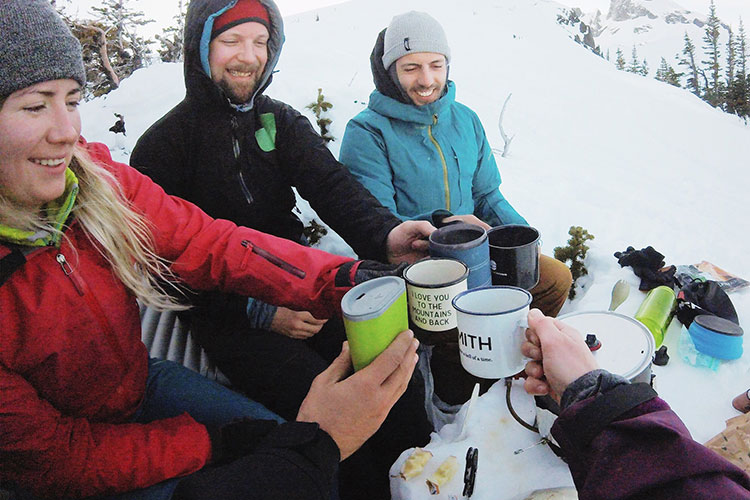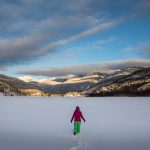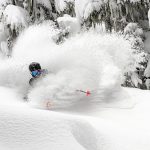Although the peaks of Whistler and Blackcomb Mountains are the ones most people come to explore in Whistler, there are other summits that call to adventurers who aren’t afraid of a little sweat equity. Black Tusk, Wedge Mountain and Rainbow Mountain are iconic backcountry peaks that dominate the landscape. You can see them from the slopes of Whistler Blackcomb, and they exude a magnetic pull for those willing to put in what’s needed to reach them.
These iconic Whistler summits can be accessed via self-propelled adventure year-round. In summer, marked trails make summit tagging pretty accessible, but what many don’t know is that strong skiers, with backcountry training, can access these beautiful giants in the winter months too.
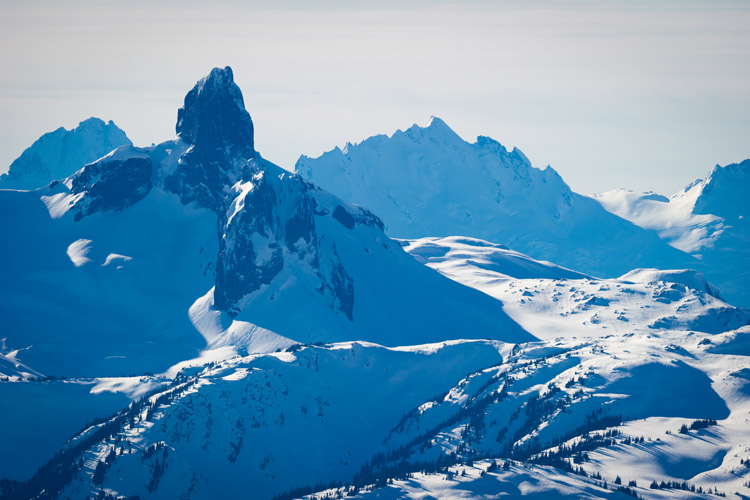
Safety First
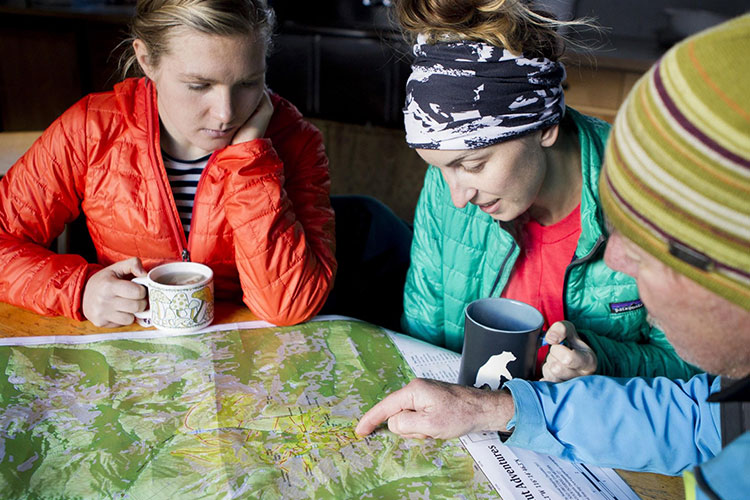
Before we tell you how you can ski some of the most predominant peaks in the valley, it’s important we relay some key safety information. If you choose to ski any of these listed iconic peaks you are entering the backcountry — a wild and unforgiving playground. You’ll need to:
- Take a formal avalanche safety training course
- Carry proper avalanche safety gear — and know how to use it
- Have experience in navigating challenging and complex terrain
- Go with someone who is equally prepared and experienced
- Check the weather forecast and avalanche conditions
- Let someone know where you are going, and when you’re planning to return.
Remember, any trip into the backcountry, regardless of time of year, warrants a first aid kit, communication devices aside from cell phones (like a satellite phone), and a small gear repair kit.
AdventureSmart has some great checklists you can use to make sure you’ve ticked all the boxes.
Whistler’s Iconic Backcountry Peaks
These peaks are not for the faint of heart or the entry-level skier, but if your skill set is a match, here’s a list of inspirational, backcountry adventures for you to consider.
BLACK TUSK
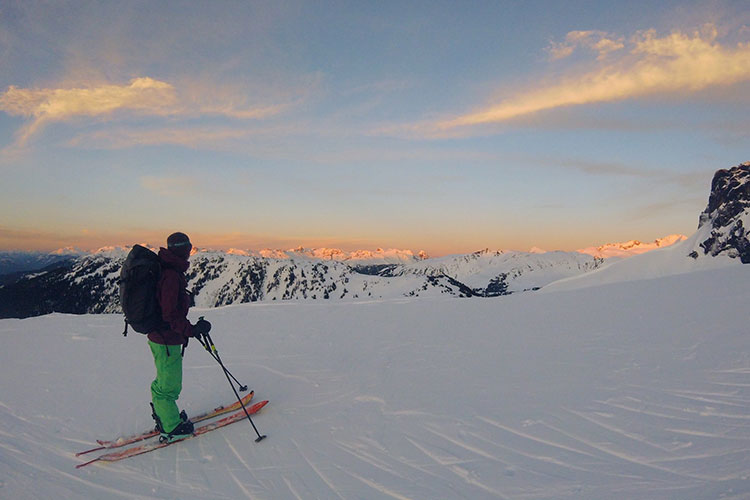
Distance: 27 kilometres
Elevation Gain: 1,735 metres
Story: A sleeping volcano, Black Tusk is the most distinct peak in the Whistler area. Once coated in glacial ice, the magma chamber from its last eruption now sits fully exposed resembling a tusk — hence, the name. It holds a sacred place in the hearts of the Squamish and Lil’wat Nations in relation to the legend of the Thunderbird, and is protected by Garibaldi Provincial Park.
Access: There are a few access points to Black Tusk, which means a variety of trip lengths. The best access depends on the time of year, but a safe bet is the summer hiking route accessed via the Rubble Creek hiking trail. It is very steep, treed, and has avalanche exposure, so use caution as per any winter, backcountry outing. Variations of this route sometimes include crossing Garibaldi Lake, which may or may not be frozen despite a snowy coating — use caution. Read about summer hiking via this route.
Access via Taylor Meadows can be obtained from the Cheakamus Lake Trail parking lot. This road is not plowed in winter, but can offer quicker access with friendlier skiing options in the early and late season when the road is drivable. The Garibaldi Provincial Park map by John Baldwin offers help when it comes to navigating, and planning to navigate, this area.
Highlights: Summiting the pronounced tusk is tricky, but oh-so-rewarding. From the top, you’ll have your choice of aspect for descending the alpine. If you happen to catch the sunrise you’ll never forget how the light paints the Tantalus Range in the distance, then kisses your face, before it moves over to Rainbow and Wedge.
WEDGE MOUNTAIN

Distance: 21 kilometres
Elevation Gain: 2,180 metres
Story: While you’re probably familiar with Wedgemount Lake as a summer hiking destination, it also makes for a mighty fine ski touring destination. However, if you’re comfortable navigating glaciers, the summit of Wedge Mountain is something else and worth the additional distance from the lake. It’s steep, exposed, and needs to be timed perfectly, which makes any summit a very special occasion. Get a feel for the summer hiking route by reading this insider blog.

Access: The Wedgemount Hiking Trail parking lot, just north of Whistler, is a great place to start. Watch out for the significant avalanche path before you reach the lake, which needs additional caution.
Some folks have accessed the area by starting on Blackcomb Mountain, then climbing East Col and descending to Wedge Creek, either from the Spearhead Glacier or down the north side of Decker Lake. The biggest challenge here is navigating the south slopes of Wedge Mountain, which are very steep and sun-exposed. The hiking trail route offers more sub-summit opportunities or objective varieties if the weather or snow stability isn’t perfect for a full summit.
The Garibaldi Provincial Park map by John Baldwin offers help when it comes to navigating and planning, and if you choose to access from Blackcomb, he also has a Whistler Blackcomb backcountry map that links the two areas together.
Highlights: The toe of the Wedge Glacier looks beautiful covered in snow. The contrasting bright blue ice is stunning. The ever-changing perspective of the Wedge area is mesmerizing, as Armchair Glacier hangs overhead and Rainbow Mountain peeps out over the opposite side of the lake.
Note: At the Wedgemount Lake area there is an emergency shelter with an outhouse, but no stove for heat.
RAINBOW MOUNTAIN

Distance: 18 kilometres
Elevation Gain: 1,600 metres
Story: Staring back at you from almost any location in Whistler, the massive Rainbow Mountain is one of the most recognizable backcountry peaks and is filled with skiable treasures on all aspects. Accessing its long list of goodies is possible from multiple directions.
Access: The Callaghan Clarke Geomatic Map is a helpful tool for showcasing all of the trails and valleys that lead to this gem. Following the summer route to Rainbow Lake is straightforward and the most simple to follow. Keep wrapping around the mountain towards Beverley Lake for additional skiing and then up to the summit.
Approaching from the north side on the Skywalk Trail is also an option. The beautiful summer destination of Iceberg Lake is a bit of a terrain trap come winter, so stay on the ridge that hosts Screaming Cat Lake and keep working towards the summit on this ridgeline.
Highlights: Rainbow Mountain has vast views of Pemberton in the north, down to Squamish in the south – the immensity of the terrain is overwhelming and will easily justify the additional weight of a camera in your pack.

Reaping the Rewards
Atop of each summit, you’ll see the other two, or four (including Whistler and Blackcomb) iconic Whistler peaks in your view. Not only is this an astonishing sight, but an absolutely incredible feeling — you’ve climbed a giant. Linger, soak in the sights and prepare for one of the longest descents of your life. You’ve most definitely earned this downhill adventure of untouched snow, vistas and thrillingly wild terrain — enjoy your well-earned reward!
Going Guided
Going with a guide is an ideal way to experience your first, big touring mission. You’ll have the opportunity to learn, ask questions, and have the safety assurance of a guide. Local companies like Extremely Canadian and Mountain Skills Academy & Adventures offer custom destination trips just like this list of iconic peaks, as well as other safety and introductory courses. I wrote about my experience with Extremely Canadian in this post: Guided Whistler Backcountry Tours with Extremely Canadian.
Backcountry Skiing Resources
When it comes to gathering beta before a trip, there is an abundance of local resources. And don’t forget to check in with yourself before, during, and after your trip to keep that human factor in check. Here is a collection of what I find to be some of the most useful and relevant resources for the Sea to Sky region.
- Backcountry Avalanche Advisory – Sea to Sky
- Avalanche Canada Forecast
- Wayne Flann Avalanche Blog
- Spot WX weather
- Arfi Weather Stations
- Google Earth
- Map Apps: Canada Topos
- Facebook Groups: South Coast Touring
Your post-adventure adrenaline high will turn this iconic peaks list into a personal bucket list, as peak summiting is addictive. Share your experiences and posts with us as you take your exploration to the next level, we welcome the FOMO feeling at #OnlyInWhistler. Start planning your backcountry, Whistler adventure with the guidance of the Whistler.com travel team.
